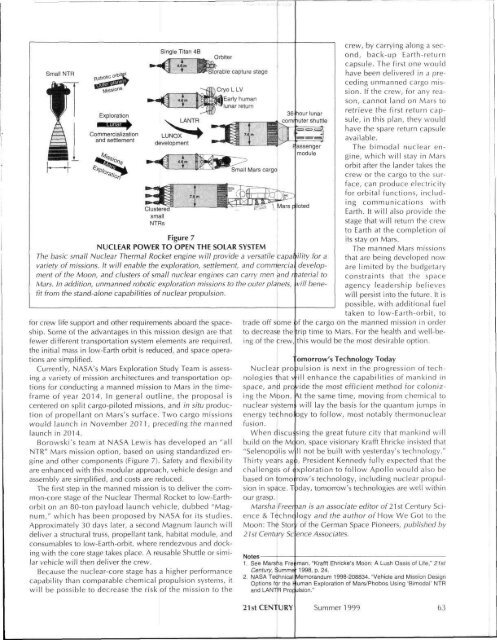Back to the Moon with Nuclear Rockets
Back to the Moon with Nuclear Rockets
Back to the Moon with Nuclear Rockets
- No tags were found...
Create successful ePaper yourself
Turn your PDF publications into a flip-book with our unique Google optimized e-Paper software.
Figure 7NUCLEAR POWER TO OPEN THE SOLAR SYSTEMThe basic small <strong>Nuclear</strong> Thermal Rocket engine will provide a versatile capability for avariety of missions. It will enable <strong>the</strong> exploration, settlement, and commercia developmen<strong>to</strong>f <strong>the</strong> <strong>Moon</strong>, and clusters of small nuclear engines can carry men and r laterial <strong>to</strong>Mars. In addition, unmanned robotic exploration missions <strong>to</strong> <strong>the</strong> outer planets, vill benefitfrom <strong>the</strong> stand-alone capabilities of nuclear propulsion.for crew life support and o<strong>the</strong>r requirements aboard <strong>the</strong> spaceship.Some of <strong>the</strong> advantages in this mission design are thatfewer different transportation system elements are required,<strong>the</strong> initial mass in low-Earth orbit is reduced, and space operationsare simplified.Currently, NASA's Mars Exploration Study Team is assessinga variety of mission architectures and transportation optionsfor conducting a manned mission <strong>to</strong> Mars in <strong>the</strong> timeframeof year 2014. In general outline, <strong>the</strong> proposal iscentered on split cargo-piloted missions, and in situ productionof propellant on Mars's surface. Two cargo missionswould launch in November 2011, preceding <strong>the</strong> mannedlaunch in 2014.Borowski's team at NASA Lewis has developed an "allNTR" Mars mission option, based on using standardized engineand o<strong>the</strong>r components (Figure 7). Safety and flexibilityare enhanced <strong>with</strong> this modular approach, vehicle design andassembly are simplified, and costs are reduced.The first step in <strong>the</strong> manned mission is <strong>to</strong> deliver <strong>the</strong> common-corestage of <strong>the</strong> <strong>Nuclear</strong> Thermal Rocket <strong>to</strong> low-Earthorbi<strong>to</strong>n an 80-<strong>to</strong>n payload launch vehicle, dubbed "Magnum,"which has been proposed by NASA for its studies.Approximately 30 days later, a second Magnum launch willdeliver a structural truss, propellant tank, habitat module, andconsumables <strong>to</strong> low-Earth-orbit, where rendezvous and docking<strong>with</strong> <strong>the</strong> core stage takes place. A reusable Shuttle or similarvehicle will <strong>the</strong>n deliver <strong>the</strong> crew.Because <strong>the</strong> nuclear-core stage has a higher performancecapability than comparable chemical propulsion systems, itwill be possible <strong>to</strong> decrease <strong>the</strong> risk of <strong>the</strong> mission <strong>to</strong> <strong>the</strong>crew, by carrying along a second,back-up Earth-returncapsule. The first one wouldhave been delivered in a precedingunmanned cargo mission.If <strong>the</strong> crew, for any reason,cannot land on Mars <strong>to</strong>retrieve <strong>the</strong> first return capsule,in this plan, <strong>the</strong>y wouldhave <strong>the</strong> spare return capsuleavailable.The bimodal nuclear engine,which will stay in Marsorbit after <strong>the</strong> lander takes <strong>the</strong>crew or <strong>the</strong> cargo <strong>to</strong> <strong>the</strong> surface,can produce electricityfor orbital functions, includingcommunications <strong>with</strong>Earth. It will also provide <strong>the</strong>stage that will return <strong>the</strong> crew<strong>to</strong> Earth at <strong>the</strong> completion ofits stay on Mars.The manned Mars missionsthat are being developed noware limited by <strong>the</strong> budgetaryconstraints that <strong>the</strong> spaceagency leadership believeswill persist in<strong>to</strong> <strong>the</strong> future. It ispossible, <strong>with</strong> additional fueltaken <strong>to</strong> low-Earth-orbit, <strong>to</strong>trade off some )f <strong>the</strong> cargo on <strong>the</strong> manned mission in order<strong>to</strong> decrease <strong>the</strong> trip time <strong>to</strong> Mars. For <strong>the</strong> health and well-beingof <strong>the</strong> crew, this would be <strong>the</strong> most desirable option." bmorrow's Technology Today<strong>Nuclear</strong> propulsion is next in <strong>the</strong> progression of technologiesthat vill enhance <strong>the</strong> capabilities of mankind inspace, and provide <strong>the</strong> most efficient method for colonizing<strong>the</strong> <strong>Moon</strong>. \t <strong>the</strong> same time, moving from chemical <strong>to</strong>nuclear system will lay <strong>the</strong> basis for <strong>the</strong> quantum jumps inenergy technology <strong>to</strong> follow, most notably <strong>the</strong>rmonuclearfusion.When discussing <strong>the</strong> great future city that mankind willbuild on <strong>the</strong> Mcon, space visionary Krafft Ehricke insisted that"Selenopolis w II not be built <strong>with</strong> yesterday's technology."Thirty years ag >, President Kennedy fully expected that <strong>the</strong>challenges of < xploration <strong>to</strong> follow Apollo would also bebased on <strong>to</strong>mo row's technology, including nuclear propulsionin space. Txiay, <strong>to</strong>morrow's technologies are well <strong>with</strong>inour grasp.Marsha Freer lan is an associate edi<strong>to</strong>r of 2'\st Century Science& Technc logy and <strong>the</strong> author of How We Got <strong>to</strong> <strong>the</strong><strong>Moon</strong>: The S<strong>to</strong>r i of <strong>the</strong> German Space Pioneers, published by21st Century Sc ence Associates.1. See Marsha Fre iman, "Krafft Ehricke's <strong>Moon</strong>: A Lush Oasis of Life," 21stCentury, Summe ' 1998, p. 24.2. NASA Technical Memorandum 1998-208834. "Vehicle and Mission DesignOptions for <strong>the</strong> \ iuman Exploration of Mars/Phobos Using 'Bimodal' NTRand LANTR Prop ulsion."21st CENTURYSummer 1999 63
















